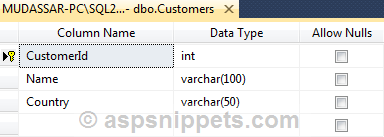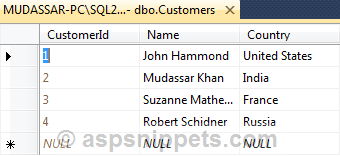Simple Cursor Tutorial with Syntax example in SQL Server
In this article I will provide a tutorial with simple example that explains
- What are Cursors in SQL Server?
- What is the syntax for writing Cursors in SQL Server?
- How to write and use Cursors in SQL Server?
- Disadvantages of a Cursor in SQL Server.
Cursor is supported in all SQL Server versions i.e. 2000, 2005, 2008, 2008R2, 2012 and 2014.
Database
I have made use of the following table Customers with the schema as follows.

I have already inserted few records in the table.

Note: You can download the database table SQL by clicking the download link below.
Download SQL file
What are Cursors in SQL Server?
Cursor is a Database object which
allows us to process each row and manipulate its data. A Cursor is
always associated with a Select Query and it will process each row
returned by the Select Query one by one.
Using Cursor we can verify each row data, modify it or perform calculations which
are not possible when we get all records at once.
A simple example would be a case
where you have records of Employees and you need to calculate Salary of
each employee after deducting Taxes and Leaves.
What is the syntax for writing Cursors in SQL Server?
Below is the syntax for writing a
Cursor. The very first thing is to declare some variables based on the
columns you are fetching in your Select Query.
Note: In this article I am considering only READ_ONLY Cursors.
Then you need to declare the Cursor
by giving it a name and setting its type as READ_ONLY and along with the
FOR keyword you need to write the Select Query which will return the
records you need to process.
Once the Cursor is setup, we need to
open it using the OPEN command and then the first record is fetched and
saved into the variable.
Whenever a record is fetched the
@@FETCH_STATUS has value 0 and as soon as all the records returned by
the Select Query are fetched, its value changes to -1.
A Cursor is associated with a WHILE LOOP which executes until the @@FETCH_STATUS has value 0.
Inside the WHILE LOOP, the processing
is done for the current record and then again the next record is
fetched and this process continues until @@FETCH_STATUS is 0.
Finally the Cursor is closed and deallocated using CLOSE and DEALLOCATE commands respectively.
Note:
It is very important to DEALLOCATE a Cursor as otherwise it will stay in
database and when you declare a Cursor with same name again, SQL Server
will throw an error: A cursor with the name 'Cursor1' already exists.

How to write and use Cursors in SQL Server?
Following is an example of simple Cursor in SQL Server which prints all the records of Customers table
--DECLARE THE VARIABLES FOR HOLDING DATA.
DECLARE @CustomerId INT
,@Name VARCHAR(100)
,@Country VARCHAR(100)
--DECLARE AND SET COUNTER.
DECLARE @Counter INT
SET @Counter = 1
--DECLARE THE CURSOR FOR A QUERY.
DECLARE PrintCustomers CURSOR READ_ONLY
FOR
SELECT CustomerId, Name, Country
FROM Customers
--OPEN CURSOR.
OPEN PrintCustomers
--FETCH THE RECORD INTO THE VARIABLES.
FETCH NEXT FROM PrintCustomers INTO
@CustomerId, @Name, @Country
--LOOP UNTIL RECORDS ARE AVAILABLE.
WHILE @@FETCH_STATUS = 0
BEGIN
IF @Counter = 1
BEGIN
PRINT 'CustomerID' + CHAR(9) + 'Name' + CHAR(9) + CHAR(9) + CHAR(9) + 'Country'
PRINT '------------------------------------'
END
--PRINT CURRENT RECORD.
PRINT CAST(@CustomerId AS VARCHAR(10)) + CHAR(9) + CHAR(9) + CHAR(9) + @Name + CHAR(9) + @Country
--INCREMENT COUNTER.
SET @Counter = @Counter + 1
--FETCH THE NEXT RECORD INTO THE VARIABLES.
FETCH NEXT FROM PrintCustomers INTO
@CustomerId, @Name, @Country
END
--CLOSE THE CURSOR.
CLOSE PrintCustomers
DEALLOCATE PrintCustomers
The following screenshot displays the records printed by the above Cursor.

You can also checkout an advanced SQL Server Cursor that sends email in my article Automated Email Notifications using SQL Server Job Scheduler.
Disadvantages of Cursor
The major disadvantage of a Cursor is
its performance issue. A Cursor can be really slow when performing
operations on large number of records and your SQL Query may take
minutes to execute and produce results.
Thus you must wisely choose and decide on the right scenario where you want to use a Cursor.
